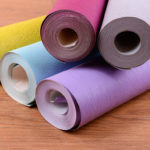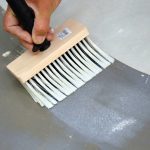Water is the basis of life, but sometimes it can cause serious damage. It is for this purpose that often during the repair of apartments of multi-storey buildings, additional insulation of the bathroom floor is made, where water is most often spilled.
How to protect the floor?
There are a huge number of methods, the use of which allows you to create a monolithic coating, similar to a pallet with side sides. Such a container can reliably protect the owner from the flow of water streams through the ceiling. In addition, the possibility of internal mold and unpleasant odors in the room will be minimized.
The selection of the most optimal type of insulation is based on the following circumstances:
- Surface condition.
- Overlap material.
- Storeys of the building.
- Ceiling height.
- Amount of time available for work.
Methods and materials
The most traditional approaches for waterproofing are:
- The use of a mixture of water-repellent type, which is able to form a dense membrane. Such insulation is applied by coating;
- Surface sizing with roll material that blocks the spread of moisture.
After thorough removal of the old coating, it is necessary to remove the oil surface or plaster from the bottom of the walls. This is necessary for placement in those places of the protective sides of the future floor.

The next step involves the preparation of the entire surface by filling cracks and polishing irregularities. The joint of the wall and the floor is ditched for the further laying of the concrete cord. Corners are particularly susceptible to moisture, therefore they require special attention.
The floor and walls are treated with soil in two layers, and the location of the communications is filled with liquid waterproofing.
Joints must be treated with bitumen mastic, and then reinforced until it dries.

Pastes or mastics are applied liberally over the entire surface of the floor. The amount of material used depends on the manufacturer. It is he who prescribes in the instructions what concentration should be on 1 m2.
After the surface dries, overlapping glued strips of insulating material (aquaizol, isoplast and others).

At the final stage, the pipes can be reprocessed with bituminous material.

Upgrading the bathroom floor in the described way will never again worry about the possibility of flooding the lower apartments.
-
 Where you should not have an electrical panel in a private house
Where you should not have an electrical panel in a private house
-
 When is it better not to glue paper wallpapers?
When is it better not to glue paper wallpapers?
-
 Top unsafe insulation
Top unsafe insulation
-
 What primers are not suitable for application under fiberboard
What primers are not suitable for application under fiberboard
-
 What is the advantage of a nichrome plexiglas cutter?
What is the advantage of a nichrome plexiglas cutter?
-
 How to disguise a beautifully gas pipe in the kitchen
How to disguise a beautifully gas pipe in the kitchen
-
 An easy way to weld cast iron: how to make a secure fit
An easy way to weld cast iron: how to make a secure fit
-
 What cheap wood impregnation is not inferior to expensive
What cheap wood impregnation is not inferior to expensive
-
 At what height should not hang a TV in the room
At what height should not hang a TV in the room
-
 What to do if the radiators are too hot
What to do if the radiators are too hot
-
 How to paint from spray can without smudges
How to paint from spray can without smudges
-
 What is often forgotten to consider when choosing a chandelier
What is often forgotten to consider when choosing a chandelier
New publications are published daily on our channel in Yandex. Zen
Go to Yandex. Zen


